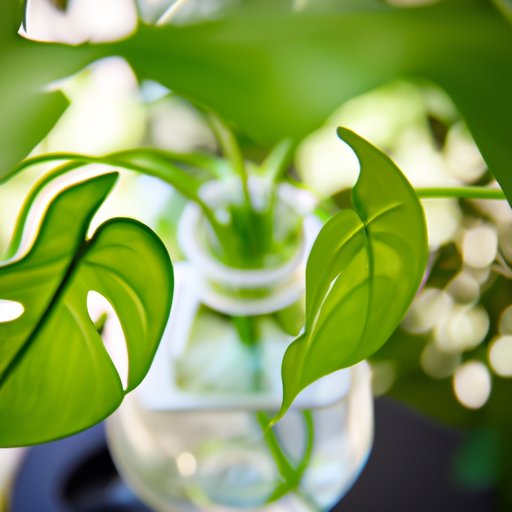Introduction
Air pollution is not only a problem in the great outdoors, but also in our homes and workplaces. The sources of indoor air pollution are numerous and can result in serious health problems. Luckily, plants can help purify the air and provide healthier indoor environments. In this article, we will introduce to you the top plants that clean the air in your home or workplace and provide you with the information you need to maintain and care for them.
Top 5 Air-Purifying Plants
If you are looking for plants that remove airborne pollutants in your home or office, you can’t go wrong with these top 5 air-purifying plants:
Spider Plant
The Spider Plant is known for its ability to remove various toxins, such as benzene, formaldehyde, and carbon monoxide. It is easy to care for and can grow even in low light conditions. To keep it thriving, simply water it weekly and it will flourish.
Aloe Vera
Aloe Vera is not just great for skin care, it is also a natural air purifier. It can absorb pollutants such as formaldehyde, benzene, and carbon dioxide. To care for your Aloe Vera, water it only when the soil becomes dry to the touch and place it near a sunny window.
Peace Lily
Peace Lily has beautiful white flowers, which is another reason to love it, but it also removes pollutants like benzene, formaldehyde, trichloroethylene, and ammonia from the air. This plant prefers low light and moist soil, so try to keep it away from direct sunlight and make sure the soil is always slightly damp.
Boston Fern
Boston Fern is another great air-purifying plant that can reduce indoor air pollutants. This plant does not like direct sunlight or drafts, so keep it away from windows and doors and avoid over-watering it.
Rubber Plant
If you are looking for an air-purifying plant with an exotic look, the Rubber Plant is calling your name. Not only will it improve your air quality by filtering out formaldehyde, but it is also easy to maintain. Keep the soil moist and place it away from the sun in a room with moderate humidity.
How Air-Purifying Plants Work
Air-purifying plants remove toxins from the air through a process called phytoremediation. In this process, plants absorb toxins from the air and soil, break them down, and release purified air back into the environment. The process is in part fueled by the plant’s natural photosynthesis. Some scientific studies have also shown that certain microorganisms in the soil of the plants can help to clean the air by breaking down harmful compounds.
Health Benefits of Air-Purifying Plants
Air-purifying plants have multiple benefits for our mental and physical health. Indoor air pollution can cause headaches, respiratory problems, allergies, and other health problems. By removing these toxins, air-purifying plants improve the quality of the air we breathe, reduce stress, and improve our overall well-being. Studies also show that having plants in your workspace can improve productivity and creativity.
DIY Air-Purifying Plants
You don’t have to go to the store to get air-purifying plants; you can create them at home with simple items. To start, purchase some indoor pots, soil, and seeds. Some of the easiest plants to grow are Spider Plants, Aloe Vera, and English Ivy. These plants require minimal care and can thrive in low light. Remember to keep them moist, but not overly watered.
Maintenance and Care
The key to maintaining healthy air-purifying plants is proper care and maintenance. Water your plants at the base and avoid getting water on the leaves. Over-watering is a common issue and can lead to root rot and plant death. Prune your plants regularly and pay attention to any changes in the leaves or roots. If your plant seems unhealthy, do some research or ask your local plant store for help.
Conclusion
In conclusion, air-purifying plants are an easy way to improve the air quality in your home or workplace. With these five top-performing air-purifying plants, DIY options and any one of them could be the answer you have been looking for. Not only do these plants improve air quality, but they also offer health benefits by reducing stress and improving overall well-being.
